[display-name-category]
[post_author]
Ever wanted a faster way to make larger-scale changes on many campaigns? Managing accounts with multiple campaigns can become a tedious and maddening task for many advertisers. Changing or even copying one variable in an ad group or campaign should be something simple and quick to do.
I experienced this myself with one of my clients. The account began fairly simple with only two U.S targeted campaigns (branded and a long tail campaign).
However, as it began to grow in the success we decided to expand to the Canadian market, and with this so did our campaigns. We quickly went from 2 campaigns to 4, and my time spent on small things such as adding the same ad to clone ad groups only for different locations was becoming too much.
What was my solution? The Shared Library.
Introduced more than 2 years ago, some of the features come in handy especially when handling larger accounts. By making the best use of this feature you will cut the amount of time you spend on things such as ads, bid strategies, budget, and keywords in half.
Where Is The Shared Library?
You’ve probably overlooked it, but it’s been right there at the bottom of the left-hand column you have become so familiar with:
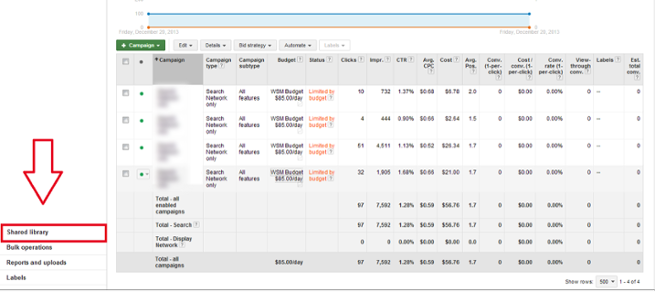
Once you click on this, you will be found with the following features:
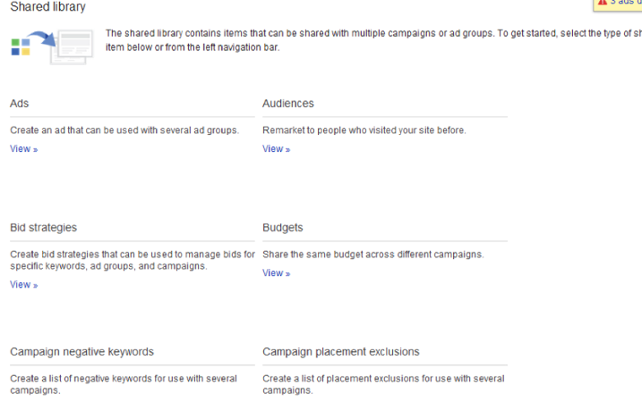
Audiences
This feature in the shared library is a one-stop-shop for your remarketing tags. The audience feature allows advertisers to quickly generate the remarketing tag that will be installed on the site, making it an easy place to go back to find it.
It also facilitates the creation of the remarketing lists according to the audiences that you wish to target, as well as custom combinations for an audience such as the “abandoned shopping cart”.
The Audiences feature in the shared library allows easy access to advertisers to view and monitor these lists as well as their progress in the accumulation of people that have been tracked via cookies within the list and gives a very good overview of the size of the audience as time progresses. There are two list sizes to take into account, one for Search and the other for Display.

Ads
In this part of the shared library, you can create ads that you will share across ad groups or campaigns. I have written an in-depth article exploring the pros and cons of using this feature in your account ‘How to Use Ads in the Shared Library‘.
Budget
The Shared Budget feature is excellent to use when you have a fixed budget to work with for multiple campaigns. In the example below, we can see that I have created 3 campaigns only for the state of California for which my client has assigned a $200 daily budget. I have created a Shared Budget titled California DB (Daily Budget) and assigned the Shared Budget to campaigns targeting California State only:
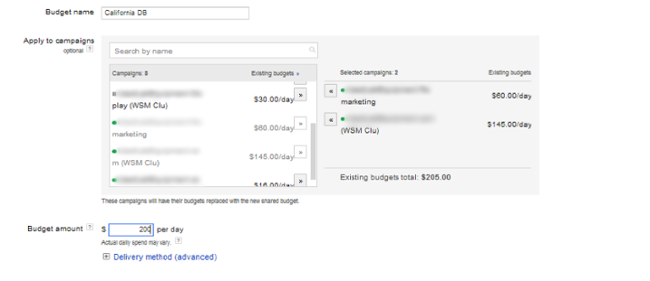
You can learn how to master this feature on this post by my colleague Ana Morales: ‘How to Use the Shared Budget in Shared Library’.
Campaign Negative Keywords
For every industry, there are always irrelevant search terms that are so pesky that they somehow manage to pop up and cost money. Historically speaking, for every campaign, there are search terms so recurrent that it is necessary to avoid them at all costs. This feature in the Shared Library comes in handy to create a universal list of negative keywords that can be applied to multiple campaigns.
You can also customize your lists for certain campaigns depending on how you have divided these according to topics. This is one of the most helpful features of the Shared library, as you can have this list on-hand anytime you create a new campaign.
For example, we have a client who offers carpentry services for custom-made wood furniture. Historically, his account and the search terms generally would attract people looking for online manuals, or DIY sites that were not interested in his services. Creating a universal list with negative keywords such as: DIY, How To, Manuals, etc. will ensure that the current campaign, as well as any in the future to which this list is applied to, will avoid these search terms.
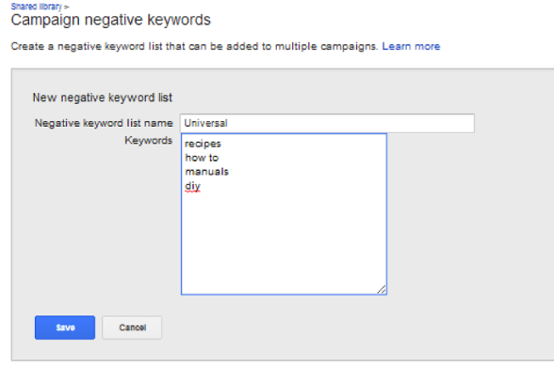
Campaign Placement Exclusions
Just as there are keywords we wish to avoid to only show for relevant searches, there are sites that should also be avoided in the Display Network. This feature also lets you create a list of placements that can be excluded amongst different display campaigns that are of no interest.
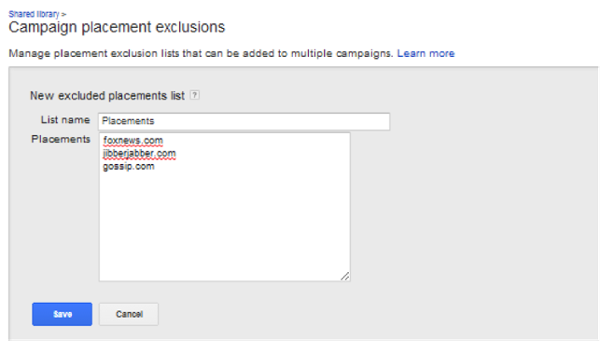
Bid Strategies
It is very important to set a bid strategy according to your campaign goals. Some campaigns can share the same bid strategies, and the Shared Library allows these to be created, stored, and applied to the desired campaigns:
Enhanced CPCs
This strategy only works with historical conversion data, in order to determine when and how much to bid on clicks that are more likely to convert. Despite being included in the shared library, this feature is still in the works to share across campaigns.
Target Search Page Location
This is more focused on bidding for an ad’s positioning, whether it is in the first place in the top results or anywhere within the first page of search results.
Target CPA
This bid strategy is particularly important for accounts where there is a determined cost per acquisition that needs to be reached in order to break even or make a profit. This bid strategy will work according to the Targeted CPA that is desired and achieve as many conversions as possible with this goal in mind.
Maximize Clicks
Primarily used for exposure of the ad and increasing the number of sales with the budget that is available. You must determine the max cost per click that you are willing to pay for as well as the daily budget in order to gain as many clicks as possible.
Target Return on Ad Spend
Return on Ad Spend is especially important when trying to achieve the highest ROI from your advertising efforts. By choosing this strategy, bids will be placed automatically in order to drive as much revenue as possible. This is a bit trickier as an analysis is needed to determine the percentage of ROAS that you would like to achieve for every dollar spent on advertising.
Considerations for the Shared Library
You probably sighed in relief now that you’ve become informed on the Shared Library on how it can help you manage your ad groups and campaigns a lot better and faster. However, in order to properly use the features of the shared library, it’s important to recognize what campaigns or ad groups share the same characteristics to which using these features will be important.
Once you’ve included these shared features, you should properly monitor the impact these have across campaigns. Since they all share the same variable, make sure each campaign achieves the desired results and that sharing feature is not hurting some of your individual campaigns.
All in all, the Shared library simplifies the management of larger accounts with multiple campaigns that share the same variables. It allows the proper organization of strategies, ads, and other features in one single space enabling advertisers to minimize tedious labor and to have more control over campaigns that seem impossible to manage at times.






